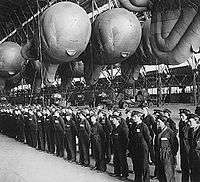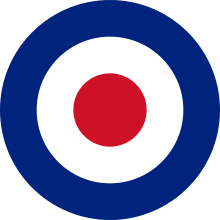Owen Tudor Boyd
| Owen Tudor Boyd | |
|---|---|
| Born |
30 August 1889 Marylebone, London |
| Died | 5 August 1944 (aged 54) |
| Allegiance | United Kingdom |
| Service/branch |
British Army (1909–18) Royal Air Force (1918–44) |
| Years of service | 1909–44 |
| Rank | Air Marshal |
| Commands held |
No. 93 Group (1944) RAF Balloon Command (1938–40) No. 1 Group (1935–36) RAF Aden (1931–34) School of Army Co-operation (1923–25) No. 24 Squadron (1922–23) No. 72 Squadron (1918) No. 66 Squadron (1917) |
| Battles/wars |
First World War Second World War |
| Awards |
Companion of the Order of the Bath Officer of the Order of the British Empire Military Cross Air Force Cross Mentioned in Despatches (2) |
Air Marshal Owen Tudor Boyd, CB, OBE, MC, AFC (30 August 1889 – 5 August 1944) was a British aviator and military officer. He served with the Royal Flying Corps during the First World War before transferring to the newly formed Royal Air Force in 1918, with which he served during the interwar period and into the Second World War.
Education and pre-war
Born in Marylebone,[1] Boyd was educated at the Royal Military College, Sandhurst. On 20 January 1909, he was appointed to a commission on the unattached list before entering the Indian Army in the same year. Boyd was an officer with the Indian Army's 5th Cavalry.[2]
First World War
From 25 April 1916, Boyd saw service in the First World War as a flying officer with the Royal Flying Corps. Later in 1916, he was a pilot on the Western Front with No. 27 Squadron; on 9 July, he was promoted to Flight Commander.[2]
Boyd stayed on the Western Front and continued to earn promotion. On 26 October, he was made Officer Commanding of a squadron and on 19 January 1917, took command of No. 66 Squadron.[2]
In June 1917, he was moved to a staff appointment and on 2 December, he was made a Staff Officer, 2nd Class, RFC (captain – graded as Brigade Major).[2]
By 7 July 1918, Boyd was in Mesopotamia as Officer Commanding No. 72 Squadron.[2]
Interwar years
From 18 January 1919, Boyd was an Officer Commanding and a Staff Officer (acting lieutenant colonel). On 1 August, he was awarded a permanent commission as a major. By 21 January 1920, he was a Staff Officer with the Mesopotamian Wing Headquarters. He was also involved as a Staff Officer with the Directorate of Operations and Intelligence.[2]
On 23 October 1922, Boyd was once again commanding a squadron, this time No. 24 Squadron.[2]
On 26 February 1923, he was made the Commandant of the School of Army Co-operation. Starting 21 January 1926, he attended the Army Staff College, Camberley. By 21 January 1928, he was on the directing staff of the college.[2]
On 4 January 1930, Boyd became the Deputy Director of Staff Duties.[2]
On 7 August 1931, Boyd was the Officer Commanding, RAF Aden. By 16 April 1934, he was Secretary of State for Air for the Headquarters Fighting Area. By 24 October 1935, he was Air Officer Commanding, Central Area.[2]
On 1 May 1936, Boyd was promoted to air commodore of No. 1 Group RAF. He was appointed Director of Personal Services at the Air Ministry in December 1936.[2]
Second World War

In 1938, as an air vice marshal, Boyd became Commander-in-Chief RAF Balloon Command. On 1 December 1940, he was replaced by Air Marshal Sir Leslie Gossage at RAF Balloon Command. Boyd was then promoted to air marshal and appointed Deputy to the Air Officer Commanding-in-Chief (AOC-in-C) Middle East.[2]
On his way to Egypt, Boyd was to stop in Malta. However, the aircraft in which he and his staff were passengers was forced down over enemy-controlled Sicily by a group of Italian fighters. There is some controversy over his capture as Boyd was indoctrinated into 'Enigma' and the advantage gained from breaking some German codes, which led to fears he could reveal this secret.[3] Secondly one history book refers to 'the reported circumstance is a navigation error and consequent fuel shortage'.[4]
After destroying his confidential papers by setting his own aircraft on fire, Boyd became a prisoner of war (POW). He spent much of the war in the Castle Vincigliata (Castello di Vincigliata) camp near Florence, Italy.[5]
When Italy capitulated in September 1943, Boyd and two British Army generals (Philip Neame and Richard O'Connor, both captured in North Africa in 1941), made use of the general confusion and escaped from their Italian captors. After some time in the Italian countryside, all three men successfully reached the Allied lines.[6]
In December 1943 the three senior officers were able to escape to a submarine; their escape was led by a Lieutenant Colonel Pat Spooner, who had escaped once before and returned to German-controlled Italy. More details in his obituary.[7]
Of all of RAF Bomber Command's wartime group commanders, Boyd spent the shortest time in command of his appointed group. In late July 1944, he was divorced. Little more than a week later, on 5 August, he was dead from a heart attack.[2]
References
- ↑ Owen Boyd – CricketArchive
- 1 2 3 4 5 6 7 8 9 10 11 12 13 "Air of Authority – A History of RAF Organisation : Air Marshal O T Boyd". Retrieved 29 November 2008.
- ↑ Wilfrid Freeman: The Genius behind Allied Survival and Air Supremacy, 1939 to 1945 by Anthony Furse
- ↑ Royal Air Force 1939–45 by Denis Richards; Vol. 1, Chap IX, p270
- ↑ "Prize Catch". Time Magazine. 2 December 1940. Retrieved 14 September 2007.
- ↑ "Generals Free". Time Magazine. 31 January 1944. Retrieved 14 September 2007.
- ↑ http://www.telegraph.co.uk/news/obituaries/11221105/Lieutenant-Colonel-Pat-Spooner-obituary.html
External links
- Air of Authority – A History of RAF Organisation – Air Marshal O T Boyd
- "Prize Catch.". Time Magazine. 2 December 1940. Retrieved 15 July 2009.
- "Generals Free.". Time Magazine. 31 January 1944. Retrieved 15 July 2009.
| Military offices | ||
|---|---|---|
| Preceded by Cuthbert MacLean As Air Officer Commanding Aden Command |
Officer Commanding RAF Aden 1931–1934 |
Succeeded by Charles Portal As Officer Commanding Aden Command |
| Preceded by Hazelton Nicholl |
Air Officer Commanding Central Area 1935–1936 |
Formation renamed as No. 1 Group |
| Preceded by J C Quinnell Quinnel's command was redesignated No. 6 Group in 1936 |
Air Officer Commanding No. 1 Group 1936 |
Succeeded by S W Smith |
| New title Command established |
Air Officer Commanding Balloon Command 1938–1940 |
Succeeded by Sir Leslie Gossage |
| Preceded by Alan Ritchie |
Air Officer Commanding No. 93 Group 1944 |
Succeeded by George Hodson |
